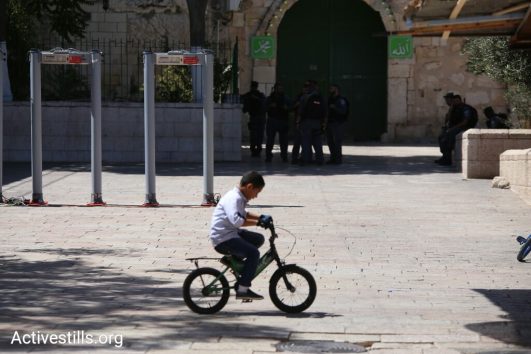After years of oppression and fragmentation, Palestinians in the occupied city are remobilizing around a common political goal.

After days of deliberations, the Israeli government finally removed metal detectors from the entrances of the Aqsa compound on Monday evening. Reports say the decision may have been linked to an agreement reached with Jordan’s King Abdullah, as part of a deal to resolve a brief diplomatic crisis that followed Sunday’s attack at the Israeli embassy in Amman.
Israeli authorities are now seeking to install “smart” cameras that can identify visitors to Al-Aqsa using facial recognition software. Palestinians argue that this technology, which can easily be abused by Israeli security services, is even worse than the metal detectors. The Islamic Waqf declared its opposition to the new plan yesterday and insisted that the status quo be restored to the situation that existed prior to a deadly shooting two weeks ago. Local worshipers continued to protest outside the Aqsa compound, and police continued to respond with stun grenades and arrests.
Despite this development, it seems that the Palestinians’ campaign of civil disobedience – largely ignored by the media’s focus on violence during the past week – is working.

The mass boycott of the metal detectors was a remarkable sight. Young headscarved women appealed (and at times shouted) to Muslim visitors not to pass through the gates. Men prayed outside or in the narrow alleys of the Old City, with some live-streaming the scenes on Facebook. Four families living inside the compound, not wanting to violate the boycott, refused to leave the premises until a special arrangement was agreed upon with the Waqf.
This united activism surprised many. Dispossessed and disenfranchised for decades, Palestinians in occupied East Jerusalem have been leaderless since the brutal suppression of the Second Intifada and further crippled by the wave of violence that erupted in September 2015. With Jewish settlements expanding and collective punishment increasing, the city’s Palestinian neighborhoods seemed to be verging toward social and economic collapse.
Now, after years of fragmentation, the community is remobilizing en masse around a common political goal. Thousands of Palestinians, under the glare of Israeli riot police, thronged the streets on July 21 in one of the largest protests the city has seen in some time. Hundreds of fellow worshippers, activists, and representatives traveled from Arab towns and cities across Israel to join them. Christians and secularists were seen standing alongside conservative Muslims in prayer, affirming that the fight for Al-Aqsa is a national cause and not just a religious one. Few Palestinians watching the news cared for Ismail Haniyeh’s sermons from Gaza or Mahmoud Abbas’ “freeze” on security coordination with Israel; all eyes were on the chanting crowds that filled Jerusalem’s streets.

If Israel thinks that smart cameras will resolve the crisis, it is grossly mistaken. For Palestinians, any new, unilateral measures at the Aqsa compound – which has already had Israeli officers guarding its gates for years – would be an extension of the massive security structures that dominate and intimidate their daily lives.
More concerning is that over the years, a growing number of Israeli politicians and groups have demanded increased Jewish access to, if not full sovereignty over, the compound, with some fanatics aspiring to build a Third Temple on the ruins of Al-Aqsa. The Ibrahimi Mosque in Hebron (Cave of the Patriarchs), which was seized and split by the army after Baruch Goldstein’s 1994 massacre, is viewed as a warning of how “security” claims could turn the compound into another military or settlement outpost. Israelis dismiss these fears as conspiracy theories; experience teaches Palestinians otherwise.
The nascent movement is thus far from over. Although acts of violence may threaten its growth, Palestinians have achieved an important step in reviving their agency in the occupied city, in spite of the numerous policies seeking to crush it. Walking in the Old City, one activist expressed hope that the events might help the community begin to rebuild the organized committees, nonviolent strategies, and popular support that guided the First Intifada 30 years ago. If not, he sighed, “God help us.”

